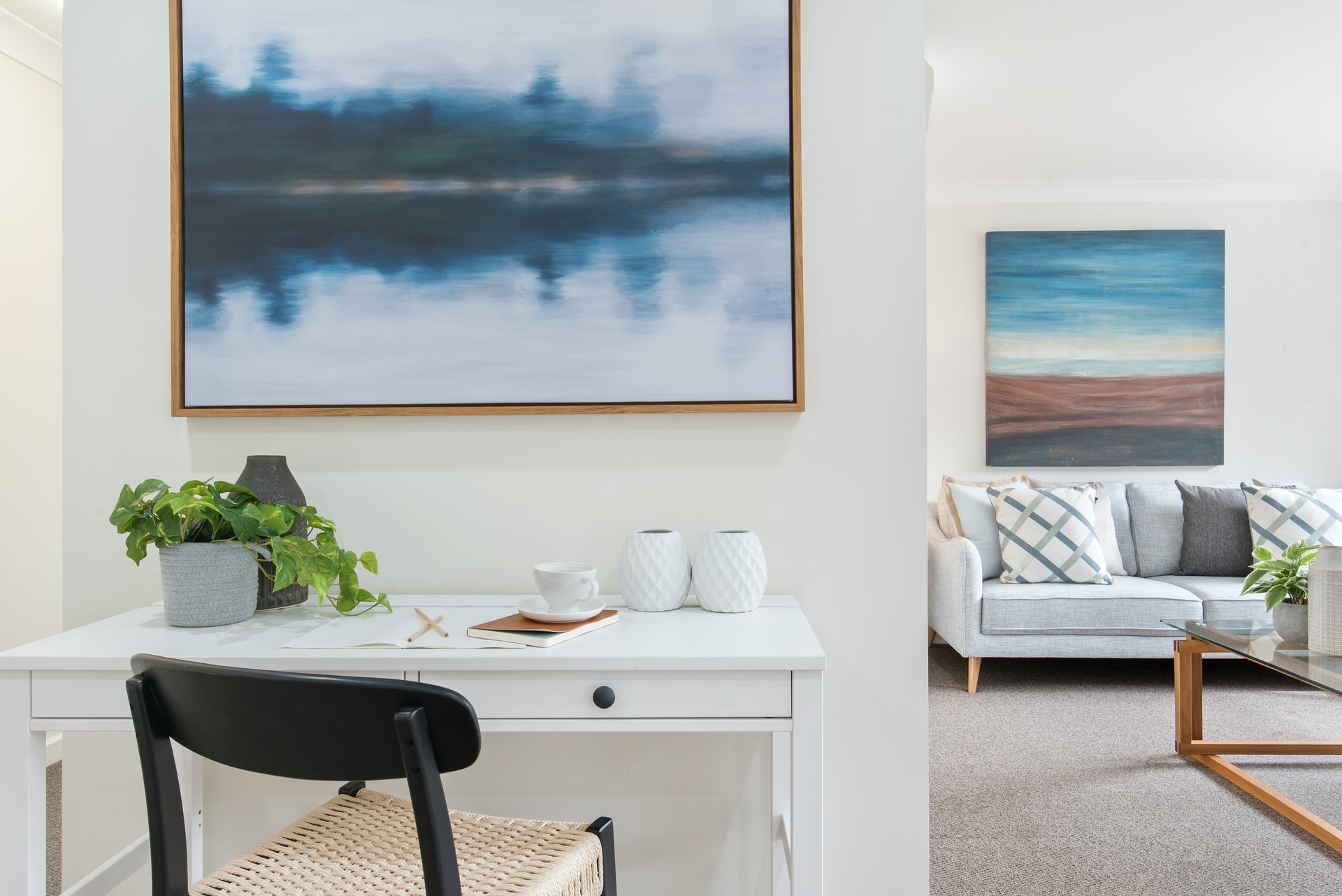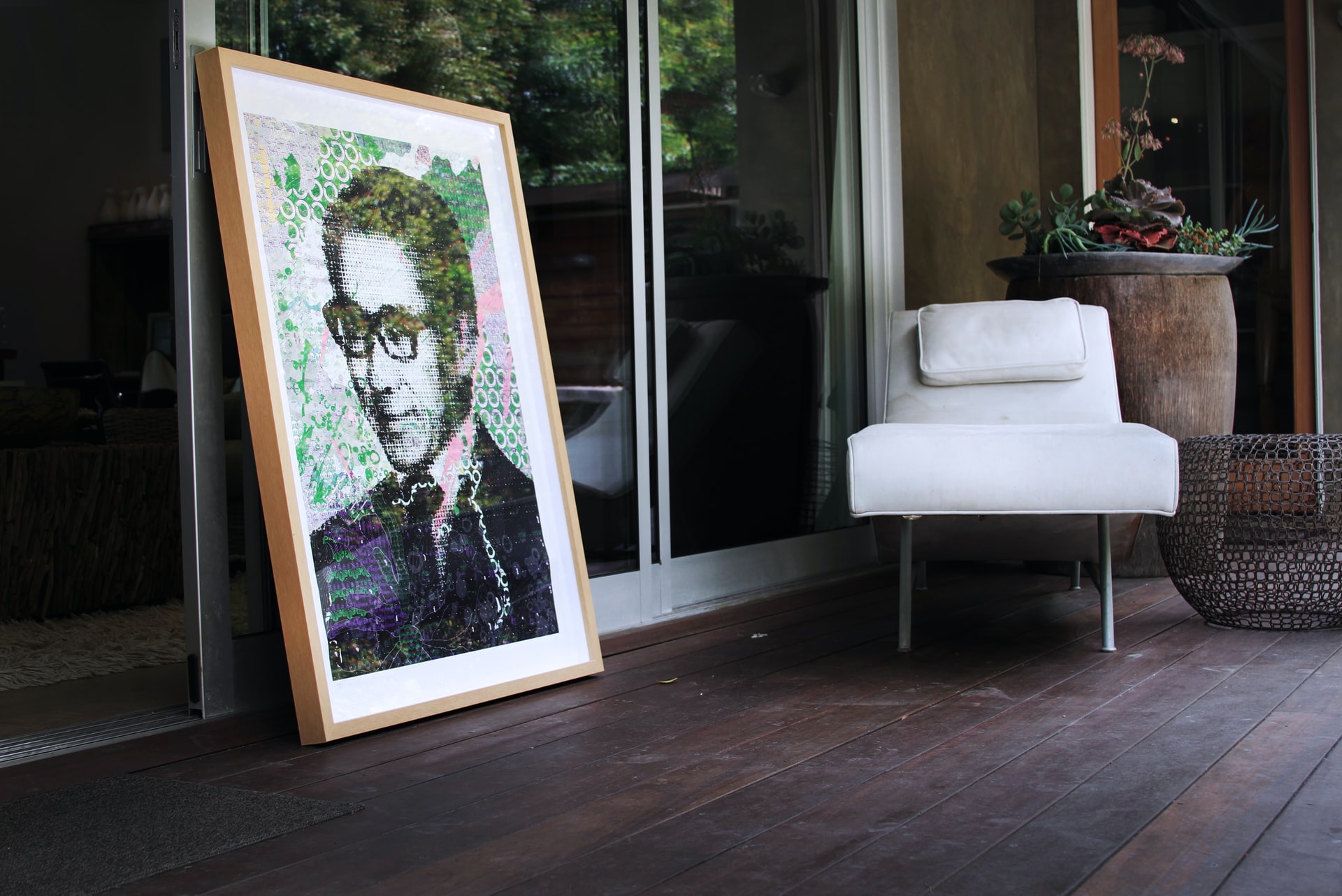There’s a certain something about seeing a piece of original artwork — it has an air of quality and authenticity that elevates a space. Great authentic artwork should inspire feeling and admiration — it’s clear when a piece is an original rather than a print, and it needs some extra care too.
As soon as you bring new artwork into your home, you can take steps to prevent it from fading, peeling, prematurely aging, or doing other undesirable things. Depending on the medium that your piece of art is in, you’ll need to take specific steps to keep each particular piece in the best condition possible. Care tips for canvas paintings differ from the medium used, like watercolor or oil paints, so knowing exactly what will keep your new home wall art in excellent condition is essential. While there are restoration efforts you can make to spruce up vintage pieces that have degraded, generally speaking, it’s much easier to preserve your artwork than it is to repair it once it’s aged or damaged.
From DIY tips to professional help, there are a plethora of options available to you to show, preserve, and store your wall decor in a way that keeps it looking fresh. Upping your wall art decor game can elevate your space from “Hm, not bad” to “Oh my gosh, it’s so elegant and welcoming here!” so read on for tips on how to keep your living room wall decor looking as lovely as the day you brought it home.
Choosing The Best Place For Your Art

Planning where to hang a piece of art is a super important part of ensuring it stands the test of time without getting damaged or degraded. Below are some key elements to keep in mind that will largely depend on your space.
Sunlight
Like wine and woodwork, sunlight is the arch-nemesis of artwork. UV rays cause the fading and loss of brilliance in colors. This is true for most paints, dyes, and photography alike. Unless you have the window film that protects from UV light or UV proof glass for your art, sunlight will cause damage.
It takes consistent exposure to sunlight over time to cause a noticeable difference, but it will add up after a while.
Temperature
Room temperature plays a huge part in the preservation of artwork. For the same reasons that libraries control their temperature, art gallery owners are meticulous about having just the right temperature. While you’re probably not on that level at home, you can still choose locations conducive to preventing damage like peeling or fading paint due to non-ideal temps.
Generally speaking, artwork is happiest at cooler temperatures. That said, if you live in Minnesota, don’t store your dining room wall decor in your unheated garage in February! Too cold, and paint will peel or crack. A slightly cooler than normal happy medium is ideal for both showing and storing your art.
Moisture
When you’re planning your room decoration and artwork storage, humidity is a huge factor to consider. Water has the potential to damage artwork just as much as sunlight but in different ways.
You can likely picture the immediate effects of something like a pipe bursting and water soaking a painting. If you can’t, let’s paint a picture for you (spoiler — it’s not great). Colors will run, the paint will flake away, irreversible damage is imminent. Watercolor or acrylic paint will run when exposed to water, and even an oil painting will likely be very damaged if it gets soaked in water. In short, it’s not a good scene.
Long-term exposure to less dramatic situations is still very detrimental to artwork differently. Humidity is a known culprit for fostering the growth of mold and mildew, and once those have gotten into canvas, canvas prints, paper, or wood, it’s tough (if not impossible) to get out without damaging the piece further.
High humidity areas like bathrooms and laundry rooms are tricky places to put artwork because they’re routinely exposed to steam and humidity from our pesky need to shower and do laundry. All is not lost, though. You can still decorate your bathroom and laundry room with wall art — you just need to plan accordingly. Canvas is generally primed before it’s painted on, and oil-based paint naturally repels water, so oil on canvas painting may hold up better in a room like a bathroom than a watercolor.
Accidental Bumps
For most of us, avoiding accidents is a Herculean feat that is likely impossible. Walls get bumped from the oopsies of daily life, and sometimes artwork suffers a dent or scratch as a result, but there are some steps you can take to make sure this doesn’t happen.
A gallery wall can be a tempting design option and is striking as a large-scale decor choice. If you’re thinking of incorporating this as a design element and you have pets or kids, definitely keep the lowest piece a healthy distance from the floor, which kiddos and pets frequently use as a freeway with little to no regard for the state of your dining room wall decor!
If you’re moving a new piece of furniture in or out, plan ahead and take your artwork off the wall to stash it somewhere that’s less likely to be dented or scratched during the moving process.
Framing

Framing is one of the best ways to keep artwork protected from becoming creased, wrinkled, or stained. It’s an easy thing to put off doing, but getting your artwork framed is step one to making sure it stands up to the trials and tribulations that life inevitably brings.
Framing Materials
Frames are generally wood or composite material and should be easy to dust and clean. If your frame is unfinished wood, be prepared for a bit of extra time when you’re dusting. Unfinished wood tends to trap dust in the grain and needs a bit of extra dusting to clean. Don’t use a wood cleaner or wax unless you take your piece out of the frame. Even if you’re super careful, you’ll likely get some on your artwork, which could stain it.
Whether or not your wall decor needs glass in its frame will depend on the medium. Oil and acrylic paintings, for example, have textures that can be squished behind glass and might not be suitable for a frame with glass. On the other hand, watercolor is on paper delicate to air exposure and will benefit from being safely tucked away behind glass. It’s a good practice not to spray your glass cleaner right onto the glass in case it runs behind the frame and gets your artwork wet.
Storage
If you’ve been a good student of this article so far, you’ll know what the biggies of art storage will be — good work! Here’s a quick recap:
Do’s
- Store your artwork in a cool (but not freezing) place. The ideal temperature range is 70-75 degrees Fahrenheit.
- Double-check that all your framing materials are acid-free.
- Store your wall decor away from the sunlight and wrap it with plastic wrap if need be.
- Store your wall art somewhere that it won’t get damp. The ideal humidity range is 40-50%.
- Take a photo of your piece before you store it, and also make notes of when it went into storage and any existing damage.
- Put your artwork in the safe hands of an art storage facility if you can.
Don’ts
- Store your artwork in your attic if you live in a warm climate. While attics might seem like dry and safe places to store artwork, if you live in an area that gets warm (even just for a few months in the summer), it can be enough to cause damage like warping, cracking, and peeling.
- Store your artwork in a basement. Like an attic, this might seem like the perfect place because it’s cool, out of the way, and out of the sun. The catch is that often basements are at least a little bit damp. If you’re confident that yours isn’t, then you might have the perfect spot!
- Put artwork in storage without a protective covering. This can be as simple as sandwiching it between two pieces of cardboard and taping up the sides. Whatever fits your piece best, just make sure that it won’t be exposed to dust and air as much as possible.
Also, make sure to take extra care of measurements when packing your artwork for shipping.
Repair Tips

Professional
If, horror of horrors, your painting gets damaged, you can always take it to a professional to repair it. There are people who specialize in restoration only; their services are on the pricier side and are generally only used for expensive pieces that need extensive repairs.
Another option is taking your piece back to the artist that made it if you can. If that’s not an option, you can ask another artist if they would be willing to make that fix for you. This will be the most economical option, and you can easily find someone in your area on social media or a quick Google search.
DIY
If, for example, you have a painting that gets scratched and the scratch is a few inches long, and on a red section of your artwork, you can muster your DIY skills, head to an art store and ask them to help you match the color and paint. Pick up a small tube of that paint and a brush, and head home to channel your inner Picasso!
If your wood frame gets a scratch, you can make some repairs with putty or a filler pen that will save you having to buy a whole new frame. Take a pic and head to your local hardware store, one of the pros there will be able to recommend the right material based on your specific frame.
Now you know what to do to take the best care of your artwork at home, so there’s no excuse for sun-bleached, faded paintings moving forward!




